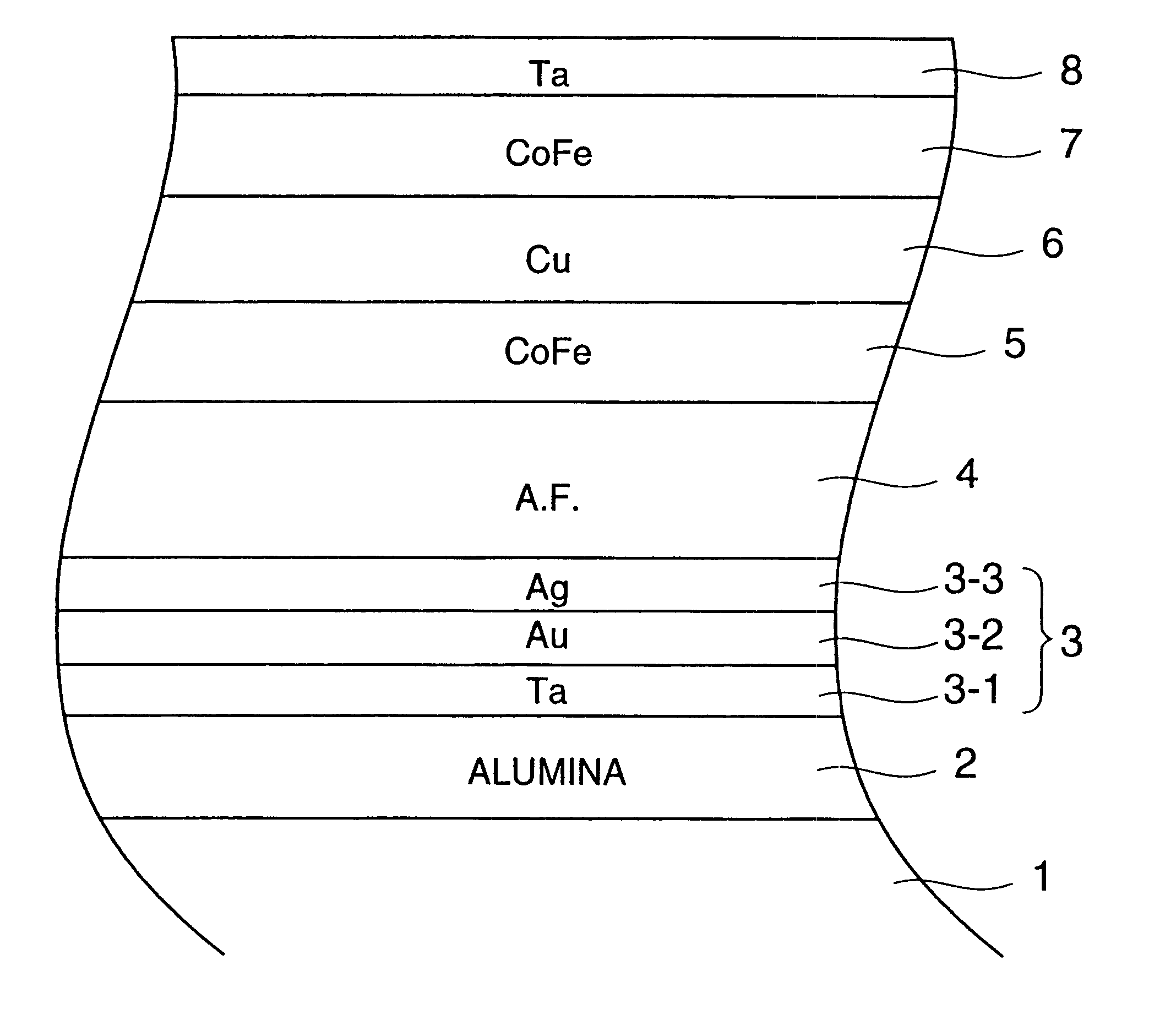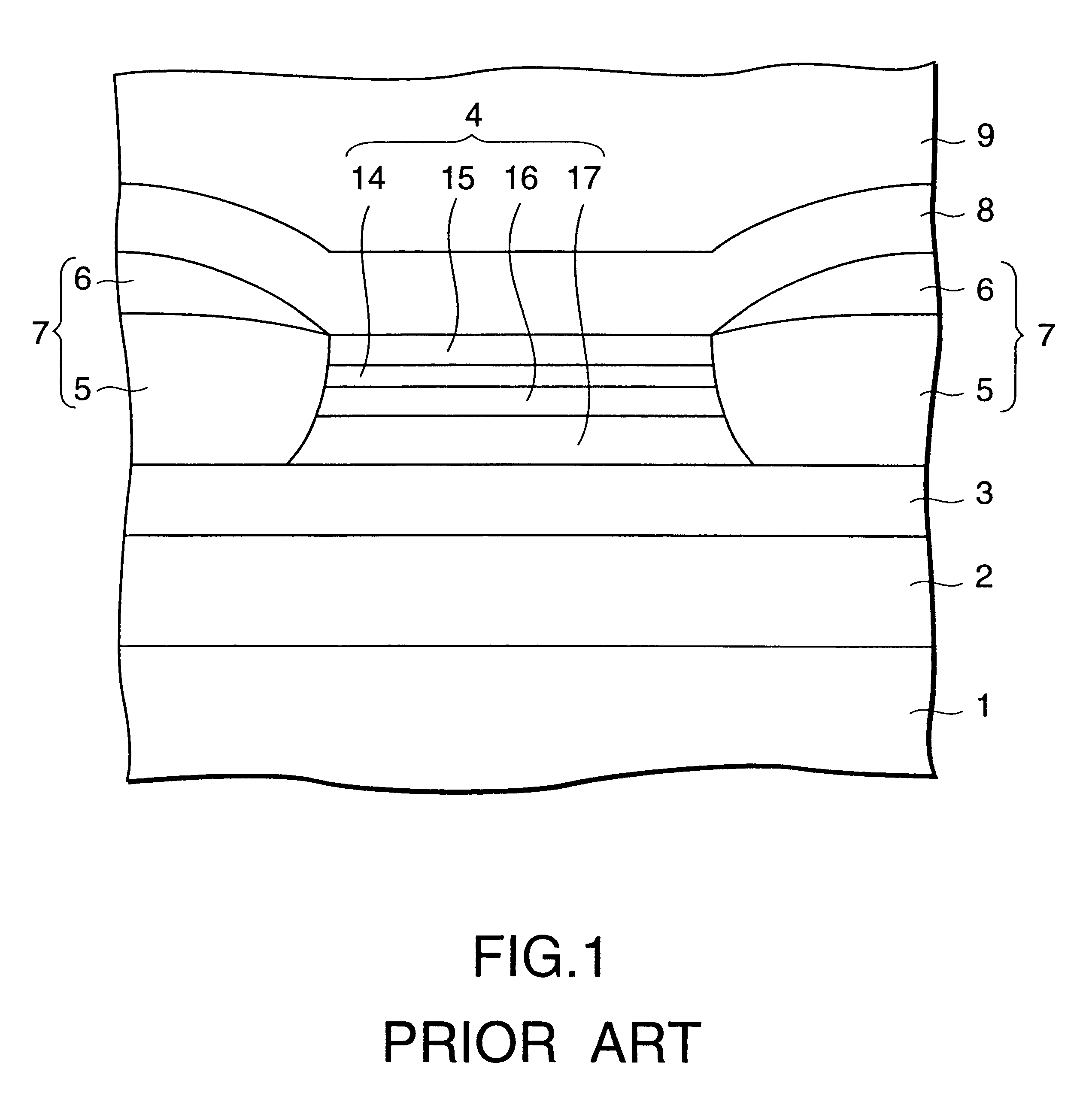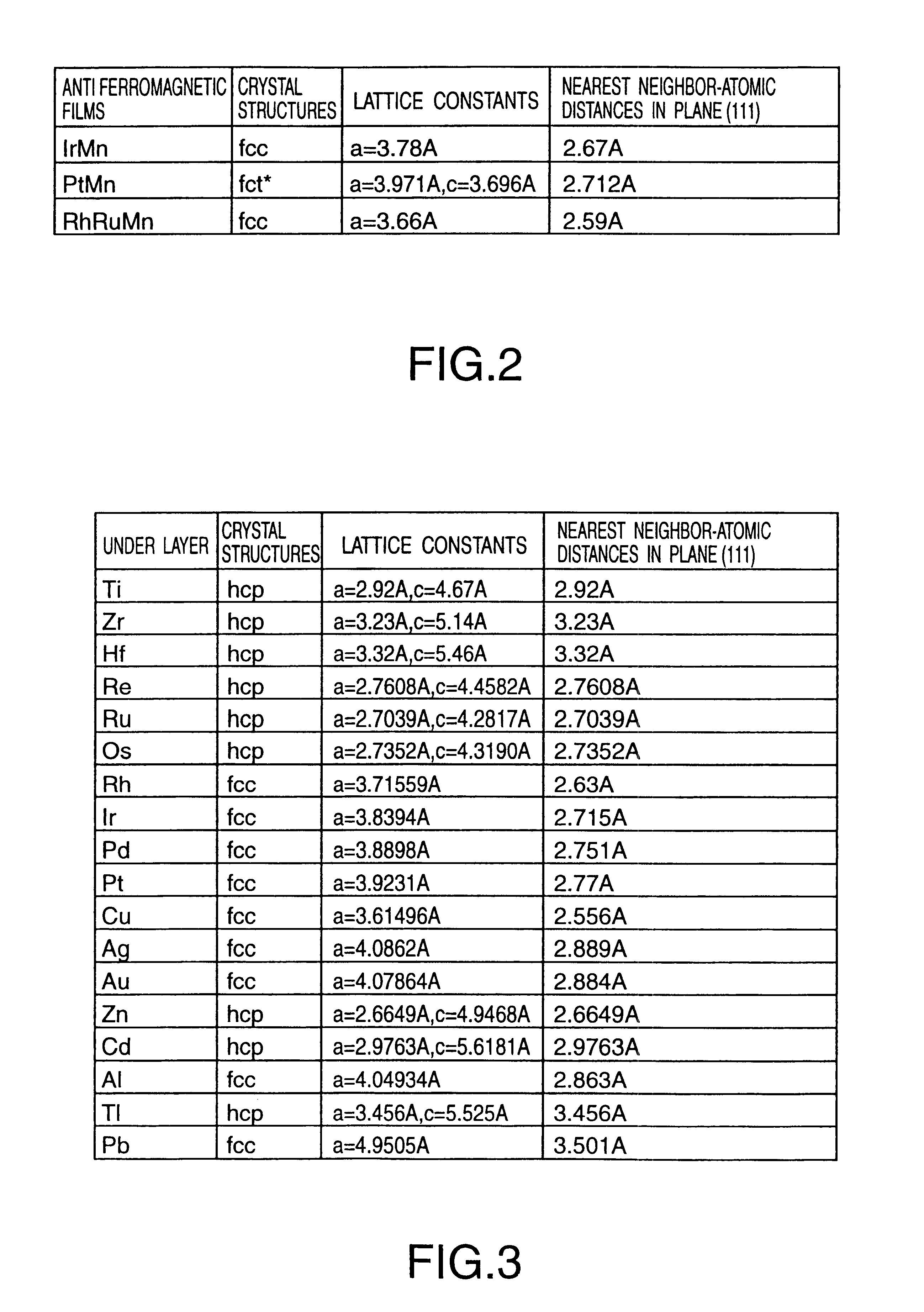Laminated magnetorestrictive element of an exchange coupling film, an antiferromagnetic film and a ferromagnetic film and a magnetic disk drive using same
a technology of antiferromagnetic film and ferromagnetic film, which is applied in the direction of nanoinformatics, magnetic bodies, instruments, etc., can solve the problems of high practical use problems, deterioration of the coupling field of the magnetoresistance effect film as a magnetoresistance element, and poor temperature characteristic of the exchange coupling field. achieve high mr ratio, efficient production of magnetoresistive elements, stable output voltage
- Summary
- Abstract
- Description
- Claims
- Application Information
AI Technical Summary
Benefits of technology
Problems solved by technology
Method used
Image
Examples
example 2
Using a DC magnetron sputtering system, the combinations of an antiferromagnetic film of IrMn and under layers of Ta (5 nm) / Au (2 nm), Ta (5 nm) / Ru (2 nm) and Ta (5 nm) / Ru (1 nm) / Au (1 nm) in the third preferred embodiment were prepared. With respect to these under layers, the dependencies of the MR ratio and the interlayer coupling on the thickness of IrMn were examined. The construction was under layer / IrMn / CoFe (2 nm) / Ru (0.9 nm) / CoFe (2 nm) / Cu (2 nm) / CoFe (2 nm) / Cu (1.5 nm) / Ta. As the cap layer, Cu was used. The results are shown in FIGS. 11 and 12. FIG. 11 shows the relationship between the thickness d (nm) of IrMn and the interlayer coupling field (Hin). FIG. 12 shows the relationship between the thickness d (nm) of IrMn and the MR ratio in each of the under layers. As can be seen from the drawings, the under layer of Ta / Au has a high MR ratio, and the under layer of Ta / Ru has a low interlayer coupling. Moreover, the under layer of Ta / Ru / Au has a high MR ratio and a low interl...
example 3
Using a DC magnetron sputtering system, the spin valve film in the third preferred embodiment was prepared. The antiferromagnetic films of IrMn and PtMn were used. At this time, Ta (5 nm) / Ru (1 nm) / NiFe (1 nm) was used as the under layer. As a result, when NiFe is combined with Ru, it was possible to obtain a low interlayer coupling field of 20 Oe or less and a high MR ratio. In addition, although the interlayer coupling field tends to increase as the thickness of the antiferromagnetic film increases, it was found that the dependence was small in the under layer of Ta (5 nm) / Ru (1 nm) / NiFe (1 nm). In addition, the same results were obtained even in the case of combinations of Rh, Ir, Cr, Re, Tc, Os other than Ru, and elements having a longer nearest neighbor atomic distance than that of the antiferromagnetic film. Moreover, with respect to NiFe, the same results were obtained even in the case of NiFe-X wherein a non-magnetizing element, such as NiFeCr, is added.
example 4
The following samples were prepared on alumina.
1 5Ta / 2Ru / 10PtMn / 2CoFe / 0.9Ru / 2.5CoFe / xCu / 2CoFe / 2Cu / 5Ta x=1.9, 2, 2.1, 2.2, 2.3, 2.4, 2.6
2 5Ta / 2NiFe / 10PtMn / 2CoFe / 0.9Ru / 2.5CoFe / xCu / 2CoFe / 2Cu / 5Ta x=1.8, 2, 2.1, 2.2, 2.3, 2.5, 2.7
3 5 Ta / 2Au / 10PtMn / 2CoFe / 0.9Ru / 2.5CoFe / xCu / 2CoFe / 2Cu / 5Ta x=1.8, 2, 2.1, 2.2, 2.3, 2.5, 2.8
All of the samples were annealed in a magnetic field of 7 kOe in vacuum of 10.sup.-6 Torr for 10 hours. All of the numbers have a unit nm.
FIG. 13 shows the results of the Hin.
The distribution of thickness of the Cu spacer estimated on the basis of these results was a normal distribution of standard deviation of about 25 im in the case of 1, and a normal distribution of standard deviation of about 0.2 nm in the case of 2. The components of the Hin based on the contribution of the magnetostatic coupling are substantially the same. However, the Ru under layer has a smaller variation due to the RKKY oscillation of the Hin in a region of from 2 nm to 2.5 nm, and the controllabili...
PUM
 Login to View More
Login to View More Abstract
Description
Claims
Application Information
 Login to View More
Login to View More - R&D
- Intellectual Property
- Life Sciences
- Materials
- Tech Scout
- Unparalleled Data Quality
- Higher Quality Content
- 60% Fewer Hallucinations
Browse by: Latest US Patents, China's latest patents, Technical Efficacy Thesaurus, Application Domain, Technology Topic, Popular Technical Reports.
© 2025 PatSnap. All rights reserved.Legal|Privacy policy|Modern Slavery Act Transparency Statement|Sitemap|About US| Contact US: help@patsnap.com



